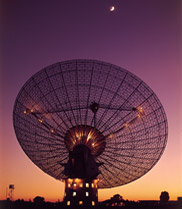Dishing on “The Dish”
In 2000, “The Dish” (watch the trailer) was the most popular movie in Australia. Half fact, half poetic-license, it highlights the role that Australia’s Parkes Observatory played in televising the first steps made on the moon. One reviewer wrote “…a real sense of the importance of it to the commun…

In 2000, “The Dish” (watch the trailer) was the most popular movie in Australia. Half fact, half poetic-license, it highlights the role that Australia’s Parkes Observatory played in televising the first steps made on the moon. One reviewer wrote “…a real sense of the importance of it to the community and the individuals therein is present throughout. An American film may have made this subservient to the moon landings; here, the two are intertwined on equal footing, and you care equally about each.”
The Parkes Observatory Web site presents the facts:
It was one giant leap for mankind, and it was taken at 12.56 pm Australian Eastern Standard Time (AEST) on Monday 21 July 1969.
Six hundred million people watched Neil Armstrong’s first steps on the Moon. Three tracking stations were receiving the signals simultaneously. They were the Commonwealth Scientific and Industrial Research Organisation’s Parkes Radio Telescope, the Honeysuckle Creek tracking station outside Canberra, and NASA’s Goldstone station in California.
The signals were relayed to Mission Control at Houston. During the first few minutes of the broadcast, NASA alternated between the signals from its two stations at Goldstone and Honeysuckle Creek, searching for the best quality images. When they switched to the Parkes pictures, they were of such superior quality that NASA remained with the Parkes TV pictures for the remainder of the 21/2-hour telecast.
It almost didn’t happen.
In late 1968 NASA had asked for Parkes to be used in the Apollo 11 mission. The giant telescope would be the prime receiving station for the reception of telemetry and TV from the surface of the Moon. Using it also provided extra gain in signal strength from the Moon. This meant that during the tightly scheduled first moonwalk the astronauts would not have to spend time setting up a large antenna to get the necessary signal strength.
At 6:17 a.m. (AEST) on 21 July, astronauts Neil Armstrong and Edwin (Buzz) Aldrin landed their LM,Eagle, on the Sea of Tranquillity. It was still some seven hours before the Moon would have risen high enough to be seen from Parkes.
The schedule required the astronauts to rest before attempting the moonwalk, by which time the Moon would have been high overhead at Parkes. However, Armstrong opted for an immediate moonwalk instead. To the astronomers at Parkes, it looked as though the moonwalk would be all over before the Moon even rose over Parkes. However, it took the astronauts such a long time to don their spacesuits and depressurise the LM cabin that as they left the module the Moon was just rising over Parkes. It seemed as though they would get the signals after all.
But suddenly troubled loomed. While fully tipped over waiting for the Moon to rise, the telescope was struck by a series of severe, 110 km per hour gusts of wind, which made the control room shudder. The telescope was slammed back against its zenith axis gears. This was a dangerous situation, threatening the integrity of the telescope structure. Fortunately, cool heads prevailed, and as the winds abated, Buzz Aldrin activated the TV camera just as the Moon rose into the telescope's field of view, and tracking began.
Using a less sensitive ‘off-axis’ detector, Parkes was able to receive the TV pictures just as the LM TV camera was switched on. Less than nine minutes later the Moon had risen into the field of view of the Parkes telescope’s main detector. Because Parkes was a larger telescope, it captured more signal and so produced better pictures. Houston switched to Parkes and remained with those pictures for the rest of the 2-1/2-hour broadcast.
Parkes staffer Neil ‘Fox’ Mason, who was seated at the control desk, drove the telescope without being allowed to once turn around and see the incoming pictures on the TV monitor. It was essential for him to monitor the tracking of the telescope, in case the winds picked up again, threatening the signal reception. The weather remained bad at Parkes, with the telescope operating well outside safety limits for the entire duration of the moonwalk.
Australia Telescope Outreach and Education sums it all up in “The Dish: Facts versus Fiction.”